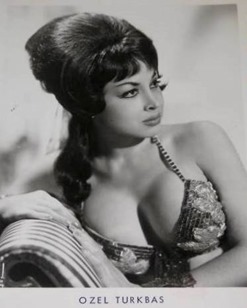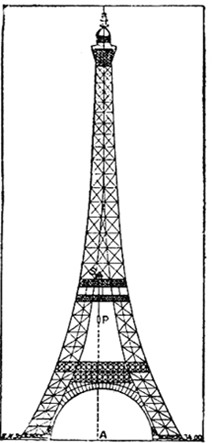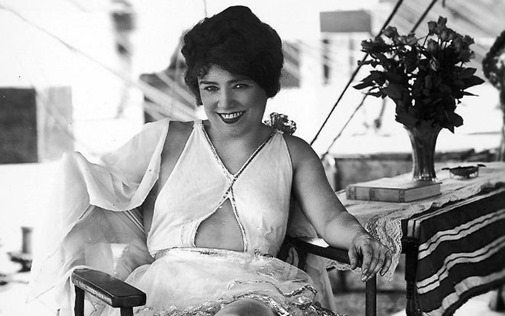
Lillian Leitzel (Jan. 2, 1892 – 1931) was an acrobat and strongwoman for the Ringling Brothers and Barnum and Bailey Circus. She was one of the highest paid performers of her generation and known for her mix of a fiery temperament 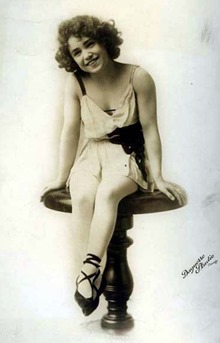 and great personal charm. Lillian Leitzel was a circus diva of the highest regard. She ruled the rings as well as the back lot during the golden age of The Greatest Show On Earth®.
and great personal charm. Lillian Leitzel was a circus diva of the highest regard. She ruled the rings as well as the back lot during the golden age of The Greatest Show On Earth®.
Lillian Leitzel was born in Breslau, Germany on January 2, 1892. Leitzel’s parents separated when Leitzel was very young and she was raised by her grandparents. Christened Leopoldina Alitza Pelikan, Lillian Leitzel took her better-known name from the Americanization of "Alitze," her Germanic nickname meaning "Little Alice." She received a quality education including advanced training in music, dance and language skills. She was fluent in 5 languages. She studied the arts at conservatories in both Breslau and Berlin and excelled at the piano. Her instructors encouraged her and it was thought that she may one day pursue a career as a concert pianist. Leitzel, however, had very different ideas. In her private time, she constructed a trapeze bar for herself and taught herself the tricks she had seen her mother and aunts perform.

Leitzel’s mother and two aunts performed in an aerial act known as the Leamy Ladies. The Leamy Ladies trapeze act was famous throughout Europe. Leitzel begged her mother to let her perform and her visits with her mother eventually lead to her participation in the act.
 Leitzel first came to the United States in 1908 as a member of the Leamy Ladies, appearing with the Barnum & Bailey show during the New York engagement that year. They returned in 1911 as a featured act with Barnum & Bailey. At the end of the 1911 season, the Leamy Ladies returned to Europe without Leitzel who remained in the United States working the vaudeville circuit. It was during this time that Leitzel honed and developed her solo Roman rings act which by then included the one-arm planges for which she is most famous. During the planges, Leitzel would separate her shoulder and throw her entire body over her shoulder again and again. It was not uncommon for Leitzel to do 100 revolutions during a performance. All the while, audiences would count out loud as Leitzel would flip over and over, "….96….97…98…99…100!" Leitzel’s record was an amazing 249 revolutions! Audiences loved her.
Leitzel first came to the United States in 1908 as a member of the Leamy Ladies, appearing with the Barnum & Bailey show during the New York engagement that year. They returned in 1911 as a featured act with Barnum & Bailey. At the end of the 1911 season, the Leamy Ladies returned to Europe without Leitzel who remained in the United States working the vaudeville circuit. It was during this time that Leitzel honed and developed her solo Roman rings act which by then included the one-arm planges for which she is most famous. During the planges, Leitzel would separate her shoulder and throw her entire body over her shoulder again and again. It was not uncommon for Leitzel to do 100 revolutions during a performance. All the while, audiences would count out loud as Leitzel would flip over and over, "….96….97…98…99…100!" Leitzel’s record was an amazing 249 revolutions! Audiences loved her.
 In November, 1914, while performing in South Bend, Indiana, a booking agent with Ringling Bros. Circus saw her act and offered her a contract on the spot. The 4 foot 9 inch, 95 pound Leitzel made her solo Big Top debut on April 17, 1915 at the Coliseum in Chicago. Leitzel was a Ring 2 headline performer from the outset where she remained throughout the rest of her life.
In November, 1914, while performing in South Bend, Indiana, a booking agent with Ringling Bros. Circus saw her act and offered her a contract on the spot. The 4 foot 9 inch, 95 pound Leitzel made her solo Big Top debut on April 17, 1915 at the Coliseum in Chicago. Leitzel was a Ring 2 headline performer from the outset where she remained throughout the rest of her life.
Leitzel was a featured performer with Ringling Bros. in 1915, 1916 and 1918, moving to the headline spot with Barnum & Bailey for the 1917 season. After the shows combined in 1919, Leitzel was considered the premier personality through 1930. Her astounding feats of strength and grueling endurance wowed Circus audiences everywhere.
Out of the spotlight, Leitzel was the first performer in history to command her own private Pullman car completely furnished with her own baby grand piano. Her quick temper was legendary. It was not uncommon to witness Leitzel  cursing or slapping a roustabout who did not adjust her rigging exactly to her liking. Further, Leitzel was known to fly off the handle and fire and rehire her personal maid, Mabel Cummings several times a day. In sharp contrast, it was the same hot tempered prima donna who was known to the children on the show as "Auntie Leitzel" and who would hold birthday parties for her fellow performers in her private dressing tent.
cursing or slapping a roustabout who did not adjust her rigging exactly to her liking. Further, Leitzel was known to fly off the handle and fire and rehire her personal maid, Mabel Cummings several times a day. In sharp contrast, it was the same hot tempered prima donna who was known to the children on the show as "Auntie Leitzel" and who would hold birthday parties for her fellow performers in her private dressing tent.
She was courted by many men who showered her with expensive gifts. In 1920, Leitzel briefly married a Ringling executive by the name of Clyde Ingalls. They divorced just four years later. Shortly after the breakup, Leitzel found her one true love in another hot tempered circus performer, legendary trapeze flyer, Alfredo Codona. Codona had made a name for himself in his family’s small Mexican circus before becoming a top star with Ringling Bros. and Barnum & Bailey®. Codona and Leitzel carried on a tumultuous romance plagued with jealousy, screaming matches and many, many breakups 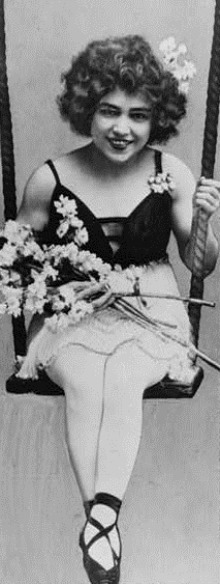 and reconciliations. Friends on the back lot said they were made for one another. The two were married on July 20, 1928 in Chicago — that is, once Leitzel finally showed up at the church. Leitzel kept Codona standing at the altar for a solid three hours awaiting her arrival. She made it clear who was in charge in her marriage.
and reconciliations. Friends on the back lot said they were made for one another. The two were married on July 20, 1928 in Chicago — that is, once Leitzel finally showed up at the church. Leitzel kept Codona standing at the altar for a solid three hours awaiting her arrival. She made it clear who was in charge in her marriage.
Leitzel and Codona were tireless performers, even scheduling engagements during the Circus’ winter break. During one of these breaks, on February 13, 1931 Leitzel was performing at Valencia Hall in Copenhagen, Denmark, and Codona at Winter Garden in Berlin. Shortly after midnight, Leitzel finished up her Roman rings presentation and ascended into the air to begin her infamous one-arm planges. On that night, the brass swivel on the rope crystallized and broke. She fell over 20 feet to a hard, concrete floor. She suffered a concussion and spinal injuries in the fall, but doctors were confident she’d recover. Codona rushed to her side. She insisted she was fine and urged Codona to return to Berlin to finish his engagement. She boarded a train with him and the pair headed back to Berlin when she died 2 days later at 2:09am, Sunday, February 15th.
Alfredo Codona was devastated by her death. He went on to remarry another aerialist named Vera Bruce, but their marriage was a miserable one. Distraught and unsettled, Codona became increasingly reckless in his act and finally suffered a bad fall as a result. Doctors informed Codona that the torn ligaments in his shoulder would prevent him from ever performing again and "grounded" him in 1937. The stress of Leitzel’s passing and the end of his circus career drove Codona to desperate measures. While discussing divorce proceedings in Vera Bruces attorney’s office, Codona asked if he could speak to his estranged wife in private. The attorney obliged and as the door closed behind the attorney, Codona pulled a pistol from his coat pocket and shot Vera Bruce before turning the gun on himself.
Leitzel is probably the first — and certainly one of the most enduring — circus luminaries of all time. Her celebrated life, tragic death and enduring legend haunts the circus world even today. She commanded top billing longer than any other circus performer in history and truly earned her position as Queen Of The Air.
Text from ringling.com
Read Full Post »















































